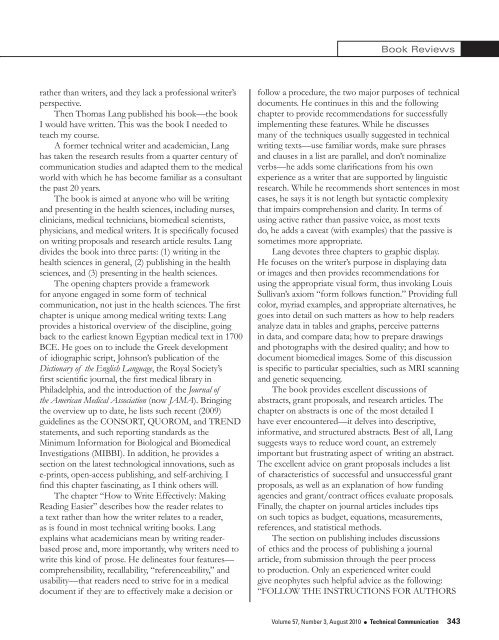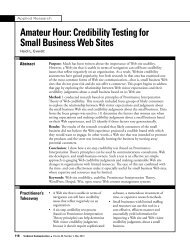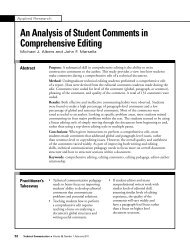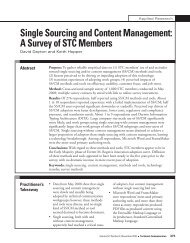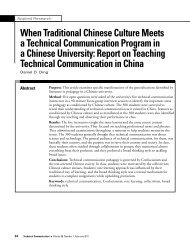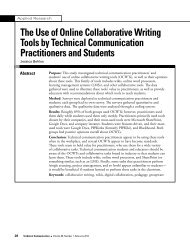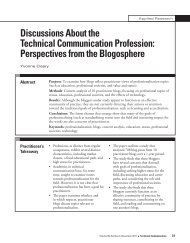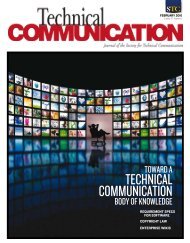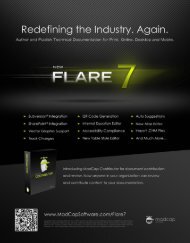CONTEXTS
Download: August 2010 - Technical Communication - Society for ...
Download: August 2010 - Technical Communication - Society for ...
- No tags were found...
You also want an ePaper? Increase the reach of your titles
YUMPU automatically turns print PDFs into web optimized ePapers that Google loves.
Book Reviewsrather than writers, and they lack a professional writer’sperspective.Then Thomas Lang published his book—the bookI would have written. This was the book I needed toteach my course.A former technical writer and academician, Langhas taken the research results from a quarter century ofcommunication studies and adapted them to the medicalworld with which he has become familiar as a consultantthe past 20 years.The book is aimed at anyone who will be writingand presenting in the health sciences, including nurses,clinicians, medical technicians, biomedical scientists,physicians, and medical writers. It is specifically focusedon writing proposals and research article results. Langdivides the book into three parts: (1) writing in thehealth sciences in general, (2) publishing in the healthsciences, and (3) presenting in the health sciences.The opening chapters provide a frameworkfor anyone engaged in some form of technicalcommunication, not just in the health sciences. The firstchapter is unique among medical writing texts: Langprovides a historical overview of the discipline, goingback to the earliest known Egyptian medical text in 1700BCE. He goes on to include the Greek developmentof idiographic script, Johnson’s publication of theDictionary of the English Language, the Royal Society’sfirst scientific journal, the first medical library inPhiladelphia, and the introduction of the Journal ofthe American Medical Association (now JAMA). Bringingthe overview up to date, he lists such recent (2009)guidelines as the CONSORT, QUOROM, and TRENDstatements, and such reporting standards as theMinimum Information for Biological and BiomedicalInvestigations (MIBBI). In addition, he provides asection on the latest technological innovations, such ase-prints, open-access publishing, and self-archiving. Ifind this chapter fascinating, as I think others will.The chapter “How to Write Effectively: MakingReading Easier” describes how the reader relates toa text rather than how the writer relates to a reader,as is found in most technical writing books. Langexplains what academicians mean by writing readerbasedprose and, more importantly, why writers need towrite this kind of prose. He delineates four features—comprehensibility, recallability, “referenceability,” andusability—that readers need to strive for in a medicaldocument if they are to effectively make a decision orfollow a procedure, the two major purposes of technicaldocuments. He continues in this and the followingchapter to provide recommendations for successfullyimplementing these features. While he discussesmany of the techniques usually suggested in technicalwriting texts—use familiar words, make sure phrasesand clauses in a list are parallel, and don’t nominalizeverbs—he adds some clarifications from his ownexperience as a writer that are supported by linguisticresearch. While he recommends short sentences in mostcases, he says it is not length but syntactic complexitythat impairs comprehension and clarity. In terms ofusing active rather than passive voice, as most textsdo, he adds a caveat (with examples) that the passive issometimes more appropriate.Lang devotes three chapters to graphic display.He focuses on the writer’s purpose in displaying dataor images and then provides recommendations forusing the appropriate visual form, thus invoking LouisSullivan’s axiom “form follows function.” Providing fullcolor, myriad examples, and appropriate alternatives, hegoes into detail on such matters as how to help readersanalyze data in tables and graphs, perceive patternsin data, and compare data; how to prepare drawingsand photographs with the desired quality; and how todocument biomedical images. Some of this discussionis specific to particular specialties, such as MRI scanningand genetic sequencing.The book provides excellent discussions ofabstracts, grant proposals, and research articles. Thechapter on abstracts is one of the most detailed Ihave ever encountered—it delves into descriptive,informative, and structured abstracts. Best of all, Langsuggests ways to reduce word count, an extremelyimportant but frustrating aspect of writing an abstract.The excellent advice on grant proposals includes a listof characteristics of successful and unsuccessful grantproposals, as well as an explanation of how fundingagencies and grant/contract offices evaluate proposals.Finally, the chapter on journal articles includes tipson such topics as budget, equations, measurements,references, and statistical methods.The section on publishing includes discussionsof ethics and the process of publishing a journalarticle, from submission through the peer processto production. Only an experienced writer couldgive neophytes such helpful advice as the following:“FOLLOW THE INSTRUCTIONS FOR AUTHORSVolume 57, Number 3, August 2010 l Technical Communication 343


